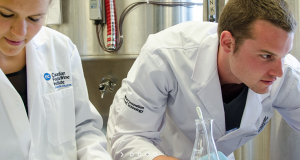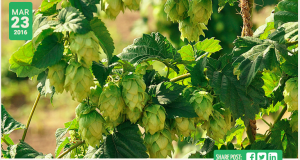By: Melanie Filotas – IPM Specialist | OMAF/MRA | ONspecialtycrops | June 2014
With the onset of downy mildew in Ontario hops over the last few weeks, there have been lots of questions about how to manage this disease. While there is a lot of excellent information on US sites on cultural practices for managing hops downy mildew, the discussion of chemical controls is not as applicable due to the limited number of products registered on hops in Canada. Here as some general guidelines on hops downy mildew fungicides for Ontario.
Before discussing chemical controls, it’s important to stress that all growers, whether conventional or organic, should be implementing standard cultural practices against hops downy mildew. Fungicides alone are not sufficient to completely control this disease. Cultural practices are aimed at removing infected material that could serve as a source of new spores and removing excess foliage to promote air movement through the canopy. These include spring pruning of basal foliage, stripping leaves, use of resistant varieties and clean planting stock, among others.
When to apply downy mildew fungicides:
- The most important thing for growers to be aware of is that most products registered for control of hops downy mildew in Canada are preventative, not curative. This means that your goal should be to have them on healthy plant tissue prior to weather events that are conducive to disease spread. Additionally, they generally do not provide season-long protection, particularly under high disease pressure situations (such as we are experiencing right now), so growers should be prepared to reapply these products in rotation throughout the season.
- Timing of fungicide applications will be weather dependent. The hops downy mildew pathogen requires high humidity (>80%) and nightly temperatures above 5?C to sporulate. When they land on a leaf surface, moisture must be present for those spores to germinate and infect the new tissue. The likelihood of infection depends on the length of time the plant tissue is wet and the temperature. Downy mildew leaf and shoot infection is most likely when there are warm, moist conditions where plant tissue remains wet for at 4-8 hours. Consequently growers should be monitoring the weather and ensuring that protective downy mildew fungicides are applied prior to weather events when sporulation and infection are likely.
- Ideal timing of fungicides for hops downy mildew has not been well studied in eastern North America. In the absence of a forecasting system, growers may want to consider fungicide rotations for downy mildews in other crops. For some of these crops, when disease pressure is low (low relative humidity, limited rainfall, cool or hot temperatures), fungicides are applied on a 10-14 day interval. Under high pressure (for hops – high rainfall and/or humidity with temperatures in the range of 8-29?C), the application interval is reduced to every 7 days.
General comments about registered products:
- While a number of products are registered against hops downy mildew, only three -Revus, Zampro and Copper 53W) are registered for in-season control. Ridomil is labelled for control of downy mildew, but can only be applied as a soil drench in early April. Acrobat and Pristine are registered for in-season use, but provide disease suppression rather than control.
- Downy mildew pathogens are very prone to becoming resistant to fungicides. To avoid this, it is important to ensure you are rotating between fungicides from different groups, as they have different modes of action, making it more difficult for the pathogen to develop resistance. Fungicide families are indicated by the fungicide group number on the product labels – different numbers mean different modes of action.
- When selecting product rotations, growers should consider activities planned in the hops yard and the date of harvest, as restricted entry and pre-harvest intervals vary among products.
Hops downy mildew products:
- Zampro – Contains two active ingredients ametoctradin (group 40) and dimethomorph (group 45). This product is effective in protecting plants against hops downy mildew and may also provide added protection against other fungal diseases. However it has an 18 day restricted entry interval for training, stripping and hand harvest, and a 12 hour rentry for all other activities. Consequently it can only be applied after training and stripping are complete and applications must stop 3 weeks prior to hand harvest (around July 28 if you plan to hand harvest by August 18). There are a maximum of 3 applications per season permitted for Zampro.
- Revus – Contains a single active ingredient, mandipropamid, which is a Group 40 fungicide. It has a 12 hour re-entry interval and a 7 day pre-harvest interval, making it more practical to apply during training or stripping and closer to hand harvest. A maximum of 3 applications per season are permitted per season, and Revus should not account for more than 50% of all downy mildew sprays in a season. Both Revus and Zampro contain group 40 fungicides; consequently they should not be applied sequentially to avoid the development of resistance. Applications of these products should be alternated with non-Group 40 products (Copper 53W or Pristine).
- Copper 53 W contains the active ingredient copper sulphate. As a group M fungicide, it is the only non-group 40 product registered for in-season control of hops downy mildew, making it the main rotational option for the Group 40 products (Revus and Zampro). It is also the only potentially organic option registered on hops, however organic growers should always check with their certifying bodies to determine acceptability of this product. It has a 48 hour re-entry interval and a 1 day pre-harvest interval. A maximum of 4 applications of Copper 53 W are permitted per year, so organic growers should time applications for periods when risk of infection is most likely. Growers considering using sheep for weed control in hops yards should also be aware that copper is toxic to sheep.
- Pristine was recently registered for control of powdery mildew and suppression of downy mildew on hops. While it only provides suppression, it contains two non-group 40 active ingredients (boscalid – group 7 – and pyraclostrobin – group 11). Consequently it may be a rotational option for Revus and Zampro if the maximum number of copper applications per season is exceeded. However, the preharvest interval for Pristine is 46 days – which would be around July 3 for an August 18 harvest.
Putting it all together
Selecting product rotation and timing will vary with the level of disease, production system, worker activities in the yard, intended date of harvest and expected interval of applications in each particular hops yard, and there is no one-size-fits-all. Some growers have asked what rotation is being used for the experimental hops yard at the Simcoe station, and the University of Guelph researchers have kindly shared this with us. Ridomil was applied to the yard in April. With disease pressure so high this year, the current plan is to follow a 7-10 day rotation beginning in late May and ending in late August just prior to harvest as follows: Copper-Revus-Copper-Revus-Zampro-Pristine-Zampro-Copper-Zampro-Revus-Copper. Growers who intend to follow a 14 day or longer rotation would be able to reduce the number of products applied, however remember that Revus should not account for more than 50% of all applications.
To read the original article, please click here.
 Ontario Hop Growers' Association The OHGA is a not-for-profit association of hop growers, families and enthusiasts who are interested in supporting the growth of the hop industry in Ontario.
Ontario Hop Growers' Association The OHGA is a not-for-profit association of hop growers, families and enthusiasts who are interested in supporting the growth of the hop industry in Ontario.


